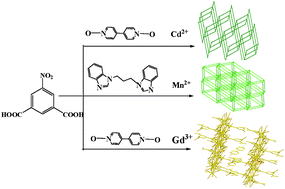Structures, photoluminescence and photocatalytic properties of three new metal–organic frameworks based on non-rigid long bridges†
Abstract
Three new metal–organic coordination

* Corresponding authors
a
Key Laboratory of Pesticide & Chemical Biology of Ministry of Education, College of Chemistry, Central China Normal University, Wuhan, P. R. China
E-mail:
dfli@ccnu.edu.cn, wenlili@mail.ccnu.edu.cn
Fax: +86 27 67867232
Tel: +86 27 67862900
b Key Laboratory of Catalysis and Materials Science of the State Ethnic Affairs Commission & Ministry of Education, South-Central University for Nationalities, Wuhan, P. R. China
c Coordination Chemistry Institute, State Key Laboratory of Coordination Chemistry, School of Chemistry and Chemical Engineering, Nanjing University, Nanjing, P. R. China
Three new metal–organic coordination

 Please wait while we load your content...
Something went wrong. Try again?
Please wait while we load your content...
Something went wrong. Try again?
D. Wang, K. Deng, K. Lv, C. Wang, L. Wen and D. Li, CrystEngComm, 2009, 11, 1442 DOI: 10.1039/B821263E
To request permission to reproduce material from this article, please go to the Copyright Clearance Center request page.
If you are an author contributing to an RSC publication, you do not need to request permission provided correct acknowledgement is given.
If you are the author of this article, you do not need to request permission to reproduce figures and diagrams provided correct acknowledgement is given. If you want to reproduce the whole article in a third-party publication (excluding your thesis/dissertation for which permission is not required) please go to the Copyright Clearance Center request page.
Read more about how to correctly acknowledge RSC content.
 Fetching data from CrossRef.
Fetching data from CrossRef.
This may take some time to load.
Loading related content
